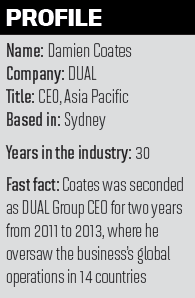

DUAL Asia Pacific CEO Damien Coates discusses how the business is working to raise SME awareness of critical risk exposures
It was 2004 when Damien Coates opened the doors of DUAL in Australia; he describes the 14 years since as a “colourful journey”.
“We now employ 150 people throughout Asia Pacific [and write] $180m in premium,” Coates says. “[We’re] the largest independently owned MGA in Asia Pacific … [and] we write 110,000 policies annually. Our motto is ‘We do boring things very well’, and that is 100% based on helping, developing and supporting SME businesses, whether it’s brokers who handle SME clients or the SME clients themselves.”
Part of that assistance includes helping SME clients address uninsured exposures.

In today’s market, Coates sees a heightened appreciation among brokers of what underwriting agencies bring to the table.
“The historic purpose of underwriting agencies 20 years ago – of being able to deal with hard-to-place [risks] – has evolved to recognition that underwriting agencies are able to be more responsive and move a lot quicker in developing solutions,” he says. “I think that’s where the underwriting agency space is so exciting. It’s in these emerging insurance lines of management liability, cyber or corporate travel that underwriting agencies have been able to move a lot quicker ... than the big insurers with their historic structures."
The year of cyber?
On 22 February, the Notifiable Data Breaches scheme came into law in Australia, imposing an obligation on organisations to notify individuals if their personal information is involved in a data breach that could result in serious harm. In light of this regime, does Coates expect a big year for cyber insurance locally?
“We have over 3,000 cyber policies in the market, and we now have over 300 cyber claims, and the claim notification rate has tripled in 2017 from what it was in 2015 and ’16, and that’s for claims coming from the malware and Cryptolocker areas of the policy,” he says. “We estimate that we’ll see the claims activity probably double [with] the mandatory breach legislation [in effect], particularly to do with the notification costs cover.”
Coates describes the outlook for cyber as exciting, given that only 2% of companies have acquired cyber coverage.
“The claims activity is already coming, and it will only increase – and that is across both Australia and New Zealand that we’re seeing a significant increase in claims activity,” he says. “I think the key thing for anyone purchasing a cyber policy is to … have a clear understanding of what the breach response service is, because what happens in that first 72 hours on a cyber breach is the most critical aspect. We’ve been very pleased to have some strong feedback from clients that have experienced our breach response service working as effectively as it should.”
Broker education is another key component of the evolving cyber insurance space.
“[Recently], we ran a webinar for brokers – one hour of education on cyber, what it covers and how to sell it, and dealing with it,” Coates says. “We originally thought 400 brokers might attend.” In fact, more than 2,100 brokers took part in the webinar.
“The demand for high-quality educational training is critical because this is one of the most frightening and least understood risks that the industry faces,” Coates says. “If we’re not educating ourselves, we have no hope of being able to educate our clients on the importance and need for cyber insurance."
Cyber isn't the only uninsured exposure that the majority of SMEs face, which represents multitude of opportunities for under-writing agencies.
"The great thing is you don't have to go far to look for opportunities because the opportunities are already here," Coates says. “Less than 15% of SMEs are purchasing management liability … 2% are buying cyber, [and] 1% are buying corporate travel … On these uninsured exposures, we haven’t even scratched the surface.”
As an industry, Coates says, insurance has a responsibility to deal with these massive uninsured exposures, which are business-critical and have resulted in substantial claims activity.
“It’s almost negligent for us, as an industry, to get distracted about further uninsured exposures until we’ve done our job in making management liability, cyber and corporate travel as compulsory an insurance purchase as property and liability,” he says. “These insurances are no longer just 'nice to haves'."
Taking on technology
When it comes to underwriters’ use of new technology, Coates believes agencies’ biggest challenge in developing solutions for SMEs isn’t the new technology itself, but instead the fear of embracing that technology.
“The hardest decision is to have the discipline to only require four pieces of information to provide a client with a management liability solution, rather than 20 pages,” he says. “In terms of communication, it’s adapting to the way people want to be communicated [with] now. People don’t want visits by BDMs pounding the pavement … They’re not looking for bricks and mortar. They’re looking for communication via webinars, three-minute videos [and] LinkedIn updates. We’re spending a lot of time on our digital marketing to ensure that our engagement is tailored in the way that brokers are looking to get information, digest it and then get back to their client.”
Coates also shares some insight into what brokers can expect from DUAL in 2018.
“We’ll continue to shape DUAL based on giving brokers what they want, rather than telling them what they need,” he says. “Our whole strategy is based on really listening to brokers, finding out what they want and delivering it in the way that they need it. So for us, the key thing is to continue to listen and then ensure that we deliver.”
